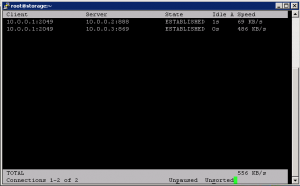

–> Processing Dependency: libuutil.so.3()(64bit) for package: zfs-2.0.86_64 –> Processing Dependency: libzfs_core.so.3()(64bit) for package: zfs-2.0.86_64 –> Processing Dependency: libzpool.so.4()(64bit) for package: zfs-2.0.86_64 –> Processing Dependency: libnvpair3 = 2.0.7 for package: zfs-2.0.86_64 –> Processing Dependency: libuutil3 = 2.0.7 for package: zfs-2.0.86_64 –> Processing Dependency: libzfs4 = 2.0.7 for package: zfs-2.0.86_64 –> Processing Dependency: libzpool4 = 2.0.7 for package: zfs-2.0.86_64 –> Processing Dependency: zfs-kmod = 2.0.7 for package: zfs-2.0.86_64
#OPENZFS SHARENFS INSTALL#
Now you can install ZFS File System on your CentOS 7 with the following command: To disable the DKMS based ZFS repository and enable kABI based ZFS repository, first open the yum configuration file of ZFS with a text editor with the following command:įirst change the enabled=1 to enabled=0 to disable the DKMS based ZFS repository.Ĭhange the enabled=0 to enabled=1 to enable the kABI based ZFS repository. So you have to disable DKMS based repository and enable the kABI based repository. When you install the ZFS repository on CentOS 7, the DKMS based repository is enabled by default. In this lab I will install the kABI based ZFS kernel module. But the kABI based ZFS module has the upper hand in that it doesn’t require recompilation if the kernel of the operating system is updated.
#OPENZFS SHARENFS UPDATE#
The difference between these is that if you install DKMS based ZFS module, and then for some reason you update the kernel of your operating system, the ZFS kernel module must be recompiled again.

There are two ways ZFS module can be loaded to the kernel, DKMS and kABI. Installing : zfs-release-1-7.9.noarch 1/1

Zfs-release noarch 1-7.9 /zfs-release.el7_9.noarch 2.9 k > Package zfs-release.noarch 0:1-7.9 will be installed Marking /var/tmp/yum-root-JLgnzc/zfs-release.el7_9.noarch.rpm to be installed Installing zfs on Centos ~]# cat /etc/redhat-release It cannot be used with any other filesystem. However, no hardware controller is required to implement RAIDZ. Traditional RAID can be implemented in hardware. In traditional systems, one can mix and match RAID levels and filesystems. ZFS can in fact handle files up to 16 exabytes in size.Ī traditional RAID is separate from the filesystem. ZFS can handle up to 256 quadrillion Zettabytes of storage – the Z in ZFS stands for Zettabyte File System).

ZFS is designed to handle large amounts of storage and also to prevent data corruption. ZFS is effectively a logical volume manager, a RAID system, and a filesystem all combined together in the one filesystem.
#OPENZFS SHARENFS SOFTWARE#
ZFS goes much further than this, including functionality that you normally require two or three separate software or operational layers in a Linux operating system. This system presents the entire array as a virtual “disk” device which from the filesystem’s perspective is indistinguishable from an actual real single disk. ZFS uses virtual storage pools known as zpools.Ī conventional RAID array is an abstraction layer that sits between the filesystem and a set of disks. ZFS is a file system created by Sun Microsystems, first shipped with Solaris but now available for other LINUX and UNIX operating systems.


 0 kommentar(er)
0 kommentar(er)
